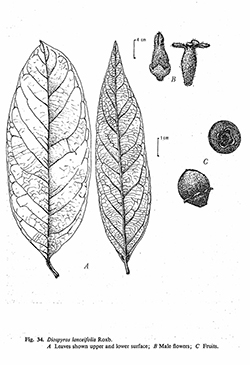e-Flora of Thailand
Volume 2 > Part 4 > Year 1981 > Page 347 > Ebenaceae > Diospyros
34. Diospyros lanceifolia Roxb.wfo-0000649192
Fl. Ind. ed. 2: 537. 1832; Hiern, Trans. Camb. Phil. Soc. 12.1: 213. 1873; Kurz, Fl. Burm. 2: 136. 1877; Clarke in Hook.f., Fl. Br. Ind. 3: 562. 1882; Bakh., Bull. Jard. Bot. Buitenzorg Sér. 3. 15: 273. 1938; H.R.Fletcher in Fl. Siam. En. 2: 372. 1938; Ng, Mal.For. 40. 4: 230. 1977.
Accepted Name : This is currently accepted.
Synonyms & Citations :
Description : Evergreen tree, up to 20 m high, twigs unarmed. Leaves lanceolate, 6–22 by 2–8 cm, base acute or obtuse, with two glands near midrib on lower surface, apex acuminate or cuspidate with blunt tip, chartaceous to subcoriaceous, ± glabrous on both surfaces; secondary nerves 5–14 pairs, arched and anastomosing well away from the margin, inconspicuous on both surfaces; reticulation inconspicuous on upper and prominent on lower surface; petiole 5–6 mm long, ± glabrous. Male flowers cymose, 4-merous, sessile. Calyx campanulate, 3–5 mm long, divided to middle; tomentose on both sides. Corolla salver-shaped. 7–12 mm long, divided to middle, sericeous outside, glabrous inside. Stamens 12–16; anthers glabrous; filaments strigose. Rudimentary ovary hirsute. Female flowers solitary, 4(–5)-merous, subsessile. Calyx campanulate, divided ± to base, tomentose on both sides. Corolla as in male flowers but larger. Ovary ovoid, tomentose, 8-locular; style single, glabrous. Staminodes 8–10, glabrous. Fruit globose, ± 2 by 2.2 cm, sessile, dry at maturity, tomentose then glabrescent except apically, brown when dry, base rounded, apex rounded and shortly apiculate; fruiting calyx divided ± to middle, tomentose outside, woolly inside; lobes erect but margin reflexed, ± undulate, not plicate and without nerves; endosperm smooth.
Thailand : PENINSULAR: Surat Thani, Trang.
Distribution : India (type), Burma, Malay Peninsula, Indonesia, the Philippines.
Ecology : In evergreen forests, 50–200 m alt. Flowering: October–December; fruiting: January–April.

